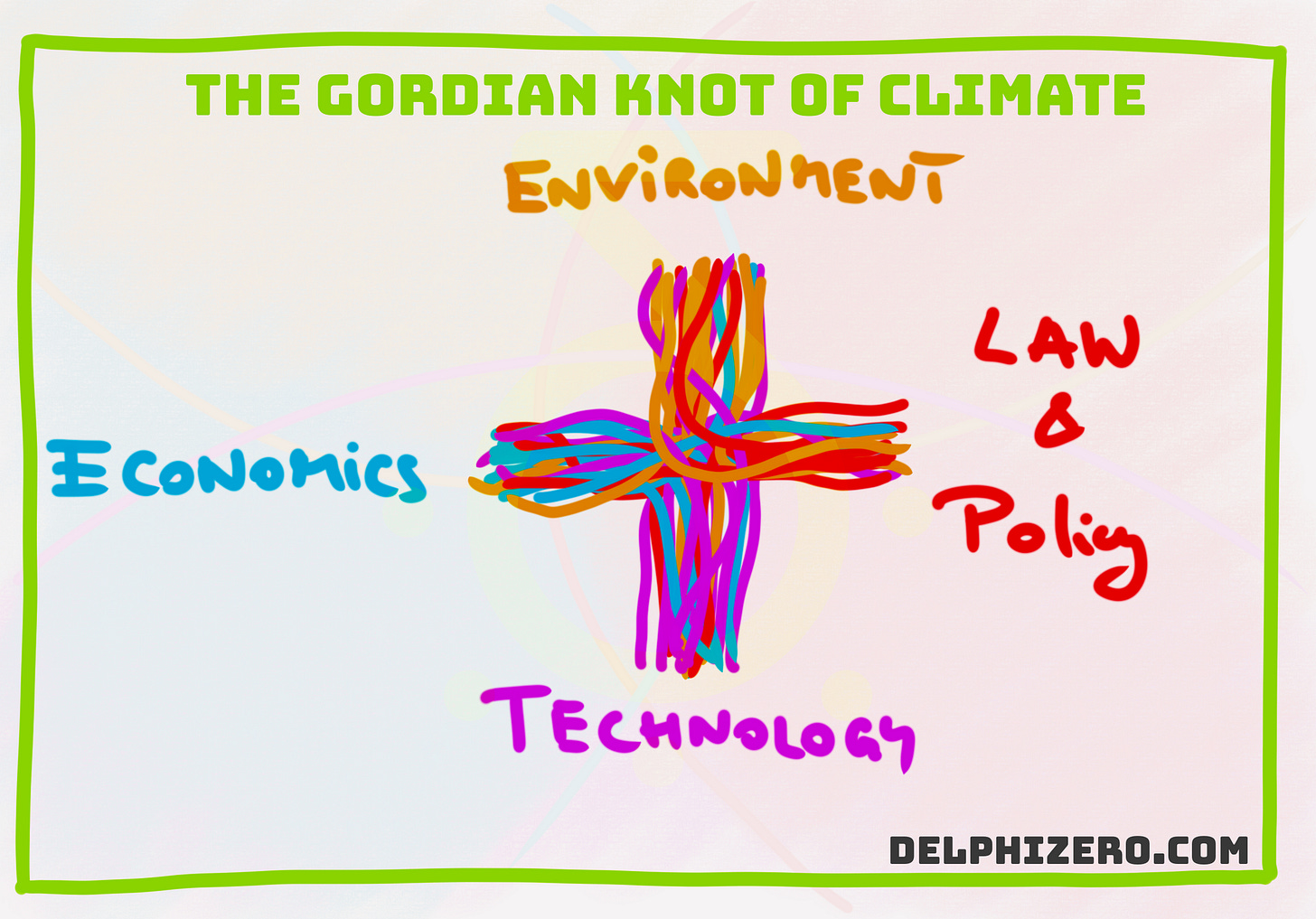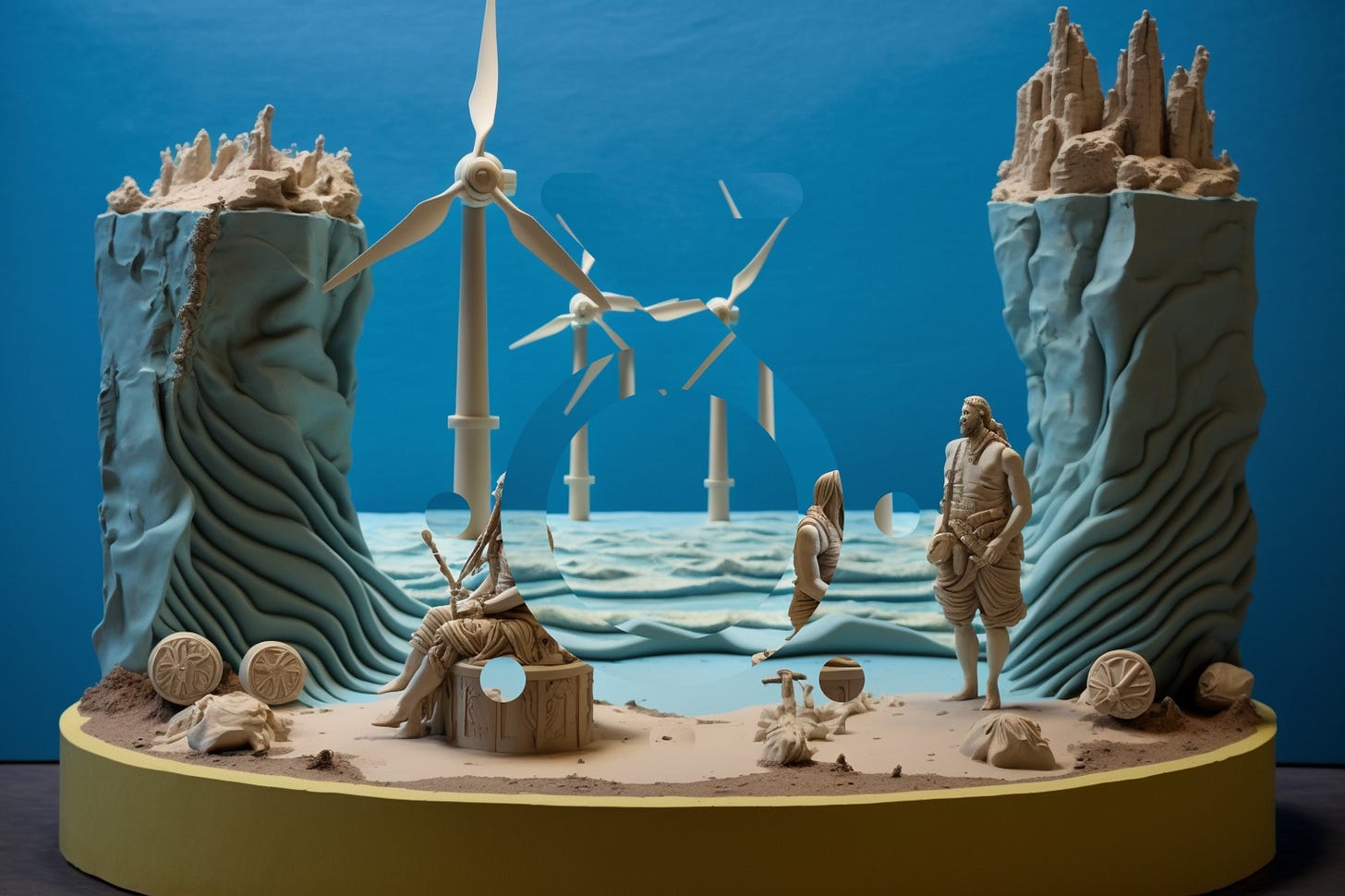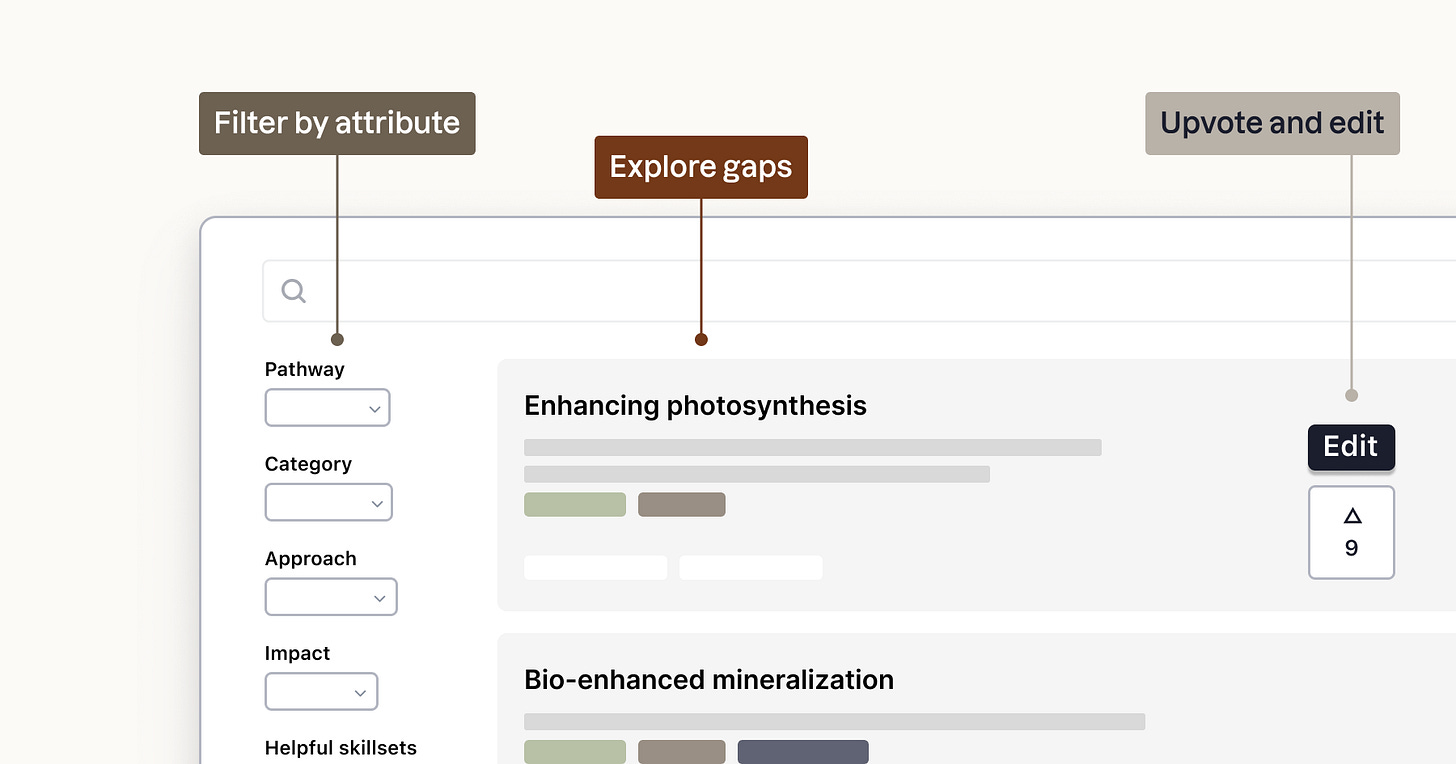The Gordian Knot of Climate
Solving climate change one thread at a time.
👋 Bonjour to 68 new readers! We are 720 climate buddies strong 🌳
Climate is not a technology problem but a story problem.
Delphi Zero is a consultancy and newsletter about the narrative potential of climate.
When people first explore climate change, it quickly dawns on them that the problem might be fuzzier and more complex than anticipated.
The same has been true for my climate journey. Initially, I started to open browser tabs whenever I encountered a new concept but I quickly realized that the scope was getting out of hand. Hundreds of tabs later, I was doubting myself and didn’t know if all of this effort would ever amount to anything. Luckily, I stuck with it and found a path for myself.
This essay is for people who are curious about climate tech but don’t know where to start. By the end of it, you should have a glimmer of hope that everyone can pull their weight.
Let’s start with mythology 🏛️
The Gordian Knot of Climate
By Art Lapinsch (all clay dioramas generated with Midjourney)
Bill Grundfest - the founder of the Comedy Cellar - said that all narrative follows the same structure: Who (subject) wants what (desire)? And what’s in the way (tension)?
In ancient times there was a fella called Alexander the Great (subject). He wanted to rule the world (desire) but the Gordian* Knot was in his way (tension). An oracle had declared that any person who could untangle this sophisticated knot would become the ruler of Asia - which from Alexander’s perspective meant the rest of the world. The crux was that the knot was impossible to untie.
*named after the ancient city of Gordion where the knot was located 👀
After futile attempts, Alexander the Great had an idea. He took his sword and cut the massive knot in half 🗡️ Bazinga! He “untied” the Gordian Knot, conquered Asia, and the rest is history.
The story's moral is that there is more than one way to solve a problem.
Sometimes it helps to reframe the problem altogether. This resolved the narrative's tension and allowed Alexander to fulfill his desire.
If he could do it, there might be a way for us to do it as well.
The Gordian Knot of Climate 🪢
tl;dr: All of us (subjects) want to live on a happy planet (desire), but climate change is in the way (tension) 🥵
How do we solve this tension? Well, that’s the million-dollar question and the starting point for climate action. At first glance, the challenge looks quite similar to the Gordian Knot. Unsolvable. Why is that?
In her essay “Finding a job in climate”, Nan Ransohoff wrote:
The goal of this step is to learn the ‘minimum amount’ to identify the parts of climate that might be a good match for your interests and skills (and, conversely, which won’t). Because climate touches most of the global economy, the trick is identifying these areas without having to understand everything about everything.
When I read this paragraph, a “mhm!” sound escaped my mouth. It resonated a lot because, initially, it felt like I had to understand everything about everything.
At first, I didn’t fully grasp why learning new climate topics would always result in hundreds of open tabs and a feeling of “how the hell am I supposed to learn all of this?!” 🤷♂️ A year into my climate journey and I still feel somewhat overwhelmed when diving into a new topic, but at least I understand why I think that way.
Nan mentioned that climate touches most of the global economy. I would break it down even further and say that most climate topics must cover four fundamental areas to be useful:
🌳 Environment: What is the impact on our planet?
🤖 Technology: How can technology and innovation be leveraged?
💶 Economics: Is it economically feasible to deliver this innovation to the market?
⚖️ Law & Policy: Does it align with the legal and political context?
When climate tech solutions overlap in those four areas, they(1) have a positive impact on our planet, (2) are doable, (3) make financial sense, and (4) work in the current set of rules we play by. This is the Gordian Knot of Climate 🪢
Albert Einstein famously said, “if he had an hour to solve a problem, he'd spend 55 minutes thinking about the problem and five minutes thinking about solutions.”
Hence, let’s follow the wise man’s method and have a look at some of the important questions 👇
Environment: Understand What’s Going On 🌳
It helps to start with the fundamental building blocks of climate change:
Greenhouse Gases (GHG): How do CO2 and other greenhouse gases trap heat in our planet’s atmosphere? What happens when temperatures rise?
Production and Removal: How do greenhouse gases get into our atmosphere and how can we remove them from the atmosphere?
Ecosystems: What are planetary boundaries and where are we at?
Once you see the edges of the problem, you can start tinkering about possible solutions.
Technology: Understand What We Can Do About It 🤖
Since we are facing a real-world problem, we need to understand real-world fundamentals:
Solutions: What are the different paths needed to solve climate change?
Natural Sciences: Which areas of physics do we need to understand? What do we need to understand about chemistry to come up with solutions? (tl;dr: a LOOOT of different areas)
Accelerants: How can other fields, such as computer science, accelerate our progress?
Most solutions will touch the real world and hence require the manipulation of atoms, sophisticated machinery, industrial processes, etc. This sh!t’s expensive. That’s why we need to think about economics.
Economics: Understand How to Market It 💶
People and businesses usually pick the most economically feasible alternative - regardless of how bad it might be for the environment. That’s why climate-friendly solutions have to compete on an economic basis.
Economics: How can we produce innovative solutions at a competitive price?
Business Models: How can we charge for our service if there’s no standard way of doing it?
Financing: How can we raise funds for potentially expensive undertakings? How does this dynamic play out when we are facing a chicken-and-egg problem (no funding = no prototype; no prototype = no validation to de-risk the investment)?
Climate-positive solutions have to make economic sense.
Law & Policy: Understand the Rules of the Game ⚖️
Lastly, climate tech solutions have to play in a given legal context. Policy and the law are tightly interlinked since political agendas steer legislation (Policy goal → policy instrument [e.g. laws, regulations, incentives, etc.] → policy outcome).
Policy: What is the big picture in current politics? What are current policy objectives?
Incentives and Constraints: Which incentive schemes are currently available (Inflation Reduction Act in the US; European Green Deal packages; REPowerEU packages; etc.)?
Laws: Which law applies (which country; which state; cross-border issues)? Which levels of the law apply (civil code; energy law; renewables laws; international law/treaties; etc.)? What is regulated and what isn’t? Which laws are about to change (new laws; updated laws; phased out laws; etc.)?
Let’s look at an example from the hydrogen space:
The common belief was that hydrogen - due to its physical properties - could be synthesized but couldn’t be extracted like natural gas. Well, turns out that we might be able to extract natural hydrogen after all. Some entrepreneurs were quick to get on this opportunity and acquired exploration rights for a region in Spain where there might be sufficient quantities of natural hydrogen.
The problem is that this exploration and extraction concession is governed under Spanish oil law, which halted all new operations. These entrepreneurs don’t want to extract harmful oil but want to extract carbon-neutral hydrogen. Yet, the law says they cannot touch. And as such, they are waiting for a legal carve out for hydrogen-related exploration/extraction.
In this case, law and policy dictate the pace of execution.
After snacking on so many questions, it becomes clear why people might feel overwhelmed when diving nose-first into climate. To make things even more complicated, the parameters in all four areas are constantly changing.
But fear not. Let me re-share Nan’s paragraph yet again and emphasize a different section:
The goal of this step is to learn the ‘minimum amount’ to identify the parts of climate that might be a good match for your interests and skills (and, conversely, which won’t). Because climate touches most of the global economy, the trick is identifying these areas without having to understand everything about everything.
In the next section, I’ll share some frequently under-indexed problem areas, which might hold interesting paths for some of you ✌️
An Ode to the Back Office 👔
When I first heard of climate tech, I immediately thought of Environment (#1) + Technology (#2).
Never in a million years did I think I could get excited about the people in the back office👇
Of course, the fundamental science is the starting point of every good solution. Of course, the ingenuity of engineers is required to come up with novel technologies to battle climate change. But more often than you’d think, big dreams come up short due to some boring details.
My friend Ben put it best: “Climate is not a technology problem. It is a business problem.”
And as such, we have to address Economics (#3) and Law & Policy (#4).
Economics: Financial Innovation to Kickstart a New Industry
tl;dr: Carbon removal facilities (subject) want to suck carbon dioxide out of the air (desire), but no one buys this service (tension).
So what the hell is Carbon Removal? It is a group of technologies that capture carbon dioxide molecules via some sort of process (mechanical; chemical; etc.) and permanently store the CO2 away.
But there’s a big problem:
A key reason permanent carbon removal is behind is that there has been legitimate uncertainty about whether there will be customers to pay for it. Unlike renewable energy, carbon removal has no immediate use to the buyer. Governments and companies might consider carbon removal to fulfill their net-zero emissions pledges, but there are cheaper options that satisfy commitments as they are written today. So even though permanent carbon removal is critical to meeting climate goals, current guidelines do not explicitly reward it.
Furthermore, the carbon removal solutions that do exist have faced a chicken-and-egg problem. As early technologies, they’re more expensive, so they don’t attract a critical mass of customers. The problem is, without customers, these companies can’t scale to reduce their costs. Not only that, but investors don’t want to invest in companies that don’t have revenue. So without customers and investment, the carbon removal ecosystem has been stuck. Nan Ransohoff (Head of Stripe Climate & Frontier Climate)
You might recognize the name. I know what it sounds like… Nan, Nan, Nan,… but hey! Credit where credit is due. Nan doesn’t only write insightful newsletters but also runs some of the most innovative teams in climate. To solve the chicken-and-egg problem for carbon removal technologies, the team had a look at other industries with similar challenges:
Development of new technology
High up-front investment required
Uncertain outcome of research and development
Decreasing costs per unit if technology proves to work
High societal value IF new technology is developed and commercialized
An industry, which looks quite similar is pharma 💉
Nan continues:
Frontier’s approach of guaranteeing demand for a new product is called an advance market commitment (AMC). The idea is to send a signal to researchers and entrepreneurs that there will be a market for a product, giving them the confidence to start building now.
AMCs are a concept we borrowed from vaccine development. In the early 2000s, low-income countries lacked access to the pneumococcal vaccine. Pharma companies weren’t motivated to spend resources developing a low-cost vaccine because they were unsure there’d be enough demand to recoup their costs. So governments and philanthropists came together and pooled $1.5bn in subsidies. Their promise was: if the pharmaceutical companies could produce the vaccine at low cost, they’d have customers to pay for them. The program delivered hundreds of millions of doses, and by some estimates saved almost a million lives.
Frontier is conceptually similar. Stripe, Alphabet, Shopify, Meta and McKinsey have pooled an initial $925M of demand to buy permanent carbon removal over the next eight years. Frontier’s team of technical and commercial experts vet suppliers to identify the most promising technologies, and then facilitate purchases between buyers and suppliers. Frontier offers pre-purchase agreements to early stage companies and offtake agreements to larger, more mature companies looking to scale. With guaranteed customers, suppliers can secure the financing needed to build their next plant, and more generally, to scale up.
An important feature of AMCs is that they allow you to send a ‘technology neutral’ demand signal. In the case of Frontier, we’ve defined what ‘great’ looks like in our target criteria (>1,000 years of permanence, path to <$100/ton, path to >0.5Gt/year, etc.) and we’re open to any solution that meets our criteria. In other words, we can signal a $1B market without needing to pick a winning technology right out of the gate.
The moral of this particular story is that financial and business model innovation can resolve the fundamental tension of a nascent market.
Law & Policy: Legal Innovation to Bypass Regulatory Roadblocks
tl;dr: We (subject) want to deploy renewable energy sources quickly (desire), but permitting law are in the way (tension).
Maybe you have seen one of these charts:

This particular chart is from the European Union, but pretty much every country and region has something that looks quite similar.
Status Quo: We have some renewable energy sources
2030: We need many more renewable energy sources
As of writing this piece (Feb’2023), we have roughly 8 years left. This is a massive problem since average permitting procedures take way too long:
If the planning and permitting of a windmill can take many years, then we should realistically scrap our 2030 targets. Ain’t gonna happen, buddy.
Luckily, there are two concurrent trends that might ease this tension: (1) Updated legislation to accelerate permitting by the reasoning of “overriding public interest” and (2) innovative legal solutions to the problem. Let me unpack the second trend. Prof. Anchustegui introduced me to a case study from Equinor - Norway’s state-owned petroleum giant 🇳🇴
Equinor’s Hywind Tampen project is awesome on so many levels:
Tech Innovation #1: First medium-sized (88MW) offshore wind farm in the world.
Tech Innovation #2: First power-to-oil/gas installation in the world. This means that clean wind energy powers the operation of the oil rig and, in doing so, reduces large amounts of emissions which would have been caused otherwise. This is an excellent example of sector coupling.
Legal Innovation: This is where things start to get juicy. The wind farm is regulated under Norwegian petroleum law since the installation (a) is only powering the oil rig, (b) doesn’t require a connection to the Norwegian electricity grid, and (c) doesn’t sell electricity to customers. As such, the Hywind Tampen project (d) could be regarded as an “extension of an existing installation”, (e) did not require a new concession, and (f) could be installed in a few months rather than a couple of years 🤯
The good news is that other operators can use this blueprint and apply it to their own projects.
Norway alone has 87 oil and gas platforms off shore. Suppose you widen the scope to a global level. In that case, you can quickly see how this legal innovation can accelerate the deployment of clean energy while reducing carbon emissions at the same time.
Resolution by a Thousand Cuts
The moral of my essay is similar to Alexander’s story: There is more than one way to solve a problem.
Maybe you’ve heard of “death by a thousand cuts” - a scenario where many small bad things add up to a big bad thing. To flip it around, I would argue that the Gordian Knot of Climate can be resolved by a thousand cuts in the discussed areas:
🌳 Environment
🤖 Technology
💶 Economics
⚖️ Law & Policy
In climate tech, we naturally gravitate towards the first two, but let us not forget that #3 and #4 have a massive impact on loosening the threads.
Climate neutrality will require all minds, not only the engineers and the scientists but also the unsung heroes in the back office. The important thing is that we all come together and start pulling the Gordian Knot of Climate.
Where will you begin?
🙏
Thanks, Nan, Ignacio, Sara, Chris, Ben, Dan, and Finn for inspiring and discussing.
If you enjoyed this essay, please consider forwarding it to a friend who wants to get started with climate 🌳
If you have feedback/ideas/critique/etc., please let me know how I can improve.
Extra Resource: Carbon Removal Knowledge Gap Database
The team at Frontier Climate put together a database of interesting problem/research areas. It is split by skillsets so that you can easily find an area, that might be a good fit for you.
Carbon removal knowledge gaps
Extra Example: Get the People Going
tl;dr: We (subject) want people to act (desire), but no one understands what’s going on (tension).
All four areas (environment, technology, economics, law & policy) if people don’t understand them enough to care. That’s why we need story tellers who can inspire and activate large audiences.
Rahul Rana put it well in his recent essay “Tell Good Stories”:
Unless there is some kind of narrative revolution that can keep abreast of our technological genius, it is unlikely that we will reach our full, amazing potential. A purely rational education will not suffice.
We need better sci-fi to guide builders who want to create a magnificent future, and dazzling spectacles to let people picture themselves in it.
It’s time to tell Good Stories again.
This is the core motivation behind writing Delphi Zero.
Newsletter Progress
As always, I’m happy to welcome new readers to Delphi Zero 🙏
Let me know what has been on your mind and if you want to read about specific topics. Since, I’m currently studying Energy Law, I’ll naturally lean towards the intersection of energy x law x climate.















